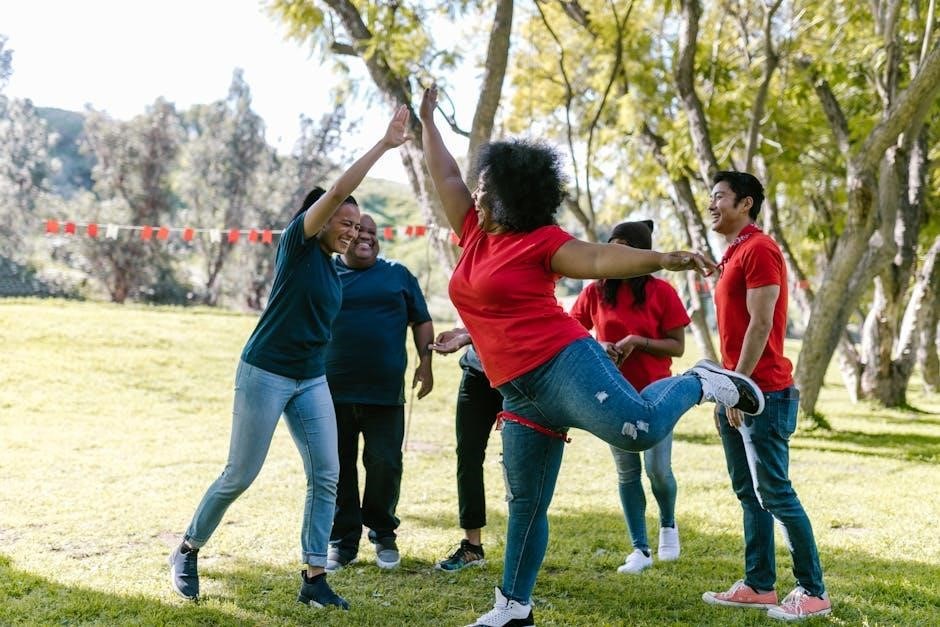Dale Carnegie’s timeless guide‚ first published in 1936‚ remains a cornerstone of self-improvement‚ offering practical advice on communication‚ leadership‚ and building lasting relationships.
Overview of the Book’s Significance
Dale Carnegie’s How to Win Friends and Influence People is a timeless self-help classic‚ first published in 1936‚ that has become an essential guide for improving interpersonal skills. Its enduring popularity stems from its practical‚ universal principles for building relationships‚ resolving conflicts‚ and inspiring others; The book has sold millions of copies worldwide and remains relevant today‚ offering insights into effective communication‚ empathy‚ and leadership. Its teachings are applicable in both personal and professional settings‚ making it a valuable resource for anyone seeking to enhance their social and professional lives. The book’s influence is a testament to its ability to address fundamental human needs across generations.
Key Themes and Principles
The book emphasizes fundamental principles like avoiding criticism‚ showing genuine appreciation‚ and understanding others’ perspectives. Carnegie stresses the importance of empathy‚ active listening‚ and positive reinforcement. He advocates for focusing on others’ interests and making them feel valued. The principles are simple yet powerful‚ encouraging readers to adopt a mindset of cooperation and mutual benefit. By mastering these techniques‚ individuals can build stronger relationships‚ influence decisions‚ and lead effectively. Carnegie’s approach is rooted in human psychology‚ making his advice both practical and enduring. These themes form the foundation of his teachings‚ offering a roadmap to personal and professional success through improved social interactions.

Part 1: Fundamental Techniques in Handling People
Mastering these core principles helps build strong relationships by avoiding criticism‚ showing appreciation‚ and understanding others’ desires‚ fostering mutual respect and cooperation effectively always.
Don’t Criticize‚ Condemn‚ or Complain
Criticism often leads to defensiveness and resentment‚ damaging relationships. People dislike being proven wrong‚ so focusing on their mistakes can harm connections. Instead‚ emphasize understanding and empathy‚ fostering a positive environment for open communication. Avoid negative feedback‚ as it rarely leads to constructive outcomes. By refraining from criticism‚ you create a space where others feel valued and respected‚ making them more receptive to your ideas. This approach builds trust and strengthens relationships‚ aligning with Carnegie’s principles of effective human interaction. Remember‚ kindness and tact are far more powerful tools than blame or disapproval in winning friends and influencing people.
Give Honest and Sincere Appreciation
Expressing genuine gratitude is a powerful way to connect with others. People thrive on recognition‚ and sincere appreciation fosters goodwill and strengthens relationships. Carnegie emphasizes that true praise‚ when specific and heartfelt‚ makes others feel valued and respected. This approach not only enhances their self-esteem but also encourages them to respond positively to your ideas. Avoid flattery or insincere compliments‚ as they can undermine trust. Instead‚ focus on meaningful acknowledgment that reflects genuine admiration. By doing so‚ you create a positive and supportive environment‚ making it easier to influence and collaborate with others. This principle is foundational to building lasting connections and earning respect.

Arouse in the Other Person an Eager Want
Part 2: Ways to Make People Like You

Become genuinely interested in others‚ smile‚ and find common ground. Show empathy‚ listen actively‚ and talk about their interests to make them feel valued and understood.
Become Genuinely Interested in Other People
Showing genuine interest in others is a cornerstone of building strong relationships. People are more likely to engage with someone who listens actively and asks thoughtful questions. Avoid interrupting and instead‚ focus on understanding their thoughts and feelings. This approach fosters rapport and trust‚ making others feel valued. Carnegie emphasizes that true interest is not about manipulating others but about sincerely caring. By being present in conversations and showing curiosity‚ you create a foundation for mutual respect and connection. Remember‚ it’s the little details—like recalling someone’s interests—that make interactions meaningful and leave a lasting impression.
Smile and Make Eye Contact
A warm smile and direct eye contact are powerful tools for connecting with others. These simple gestures convey friendliness‚ confidence‚ and sincerity‚ making people feel at ease. Carnegie stresses that smiling is one of the most basic yet effective ways to create a positive first impression. Eye contact‚ when done naturally‚ builds trust and shows genuine interest in the conversation. Avoiding eye contact can signal disinterest or dishonesty‚ while maintaining it fosters deeper connections. These non-verbal cues are subtle but impactful‚ helping to establish rapport and make interactions more meaningful. They are essential for building the foundation of any successful relationship.
Find Common Ground
Connecting with others becomes easier when you find common ground‚ such as shared interests‚ experiences‚ or goals. This principle encourages you to explore topics that resonate with the person you’re engaging with. By showing genuine curiosity and asking open-ended questions‚ you can uncover mutual points of interest. Carnegie emphasizes that people are more likely to engage with someone who understands and relates to their perspective. Finding common ground fosters rapport‚ making conversations more enjoyable and meaningful. It also helps in building trust and creating a foundation for deeper connections. This approach is simple yet effective in making others feel valued and understood.
Be a Good Listener

Being a good listener is a powerful way to connect with others and build rapport. People feel valued when they are truly heard‚ and listening demonstrates respect and genuine interest. Carnegie emphasizes the importance of giving others your undivided attention‚ avoiding interruptions‚ and letting them express themselves fully. By doing so‚ you create a safe space for open communication. Listening also helps you understand their needs‚ desires‚ and perspectives‚ making it easier to find common ground. This simple yet profound skill fosters trust‚ strengthens relationships‚ and makes others feel important. It’s a cornerstone of effective communication and a key principle in winning friends and influencing people.
Talk About the Other Person’s Interests
Talking about the other person’s interests is a powerful way to build rapport and make them feel valued. People are naturally drawn to those who show genuine interest in their passions‚ hobbies‚ or goals. By asking questions and engaging in conversations about their interests‚ you create a sense of connection and importance. This principle‚ emphasized by Carnegie‚ helps shift the focus from yourself to others‚ making interactions more enjoyable and meaningful. It’s not about flattering or pretending but showing sincere curiosity. When you prioritize their interests‚ you foster trust‚ deepen relationships‚ and create a foundation for mutual understanding and influence. This approach is timeless and universally effective in building strong connections.
Make People Feel Important
Making people feel important is a cornerstone of building strong relationships‚ as emphasized by Carnegie. Simple gestures like acknowledging their achievements‚ showing genuine interest in their thoughts‚ and using their name can create a profound impact. When you make someone feel significant‚ they are more likely to respond positively to you. This principle fosters loyalty‚ trust‚ and mutual respect. It’s not about flattery but sincere recognition. By prioritizing their feelings of importance‚ you cultivate deeper connections and create a lasting impression. This approach is essential in both personal and professional settings‚ helping you influence others effortlessly while strengthening your relationships.
Part 3: How to Win People to Your Way of Thinking
Master the art of persuasion by avoiding arguments‚ admitting mistakes‚ and using empathy. Employ the Socratic method to guide others to your perspective gently and effectively.
Avoid Arguments
Avoiding arguments is crucial for harmonious relationships. When disagreements arise‚ focus on understanding rather than winning. Acknowledge the other person’s perspective and show respect‚ even if you disagree. Avoid being confrontational or defensive‚ as this can escalate tensions. Instead‚ seek common ground and aim for a mutually beneficial solution. Remember‚ the goal is to maintain rapport‚ not to prove a point. By sidestepping arguments‚ you foster an environment of trust and cooperation‚ making it easier to influence others positively.
- Stay calm and composed during disagreements.
- Listen actively to the other person’s viewpoint.
- Avoid taking a confrontational tone.
- Focus on finding a resolution rather than “winning.”
Admit When You’re Wrong

Admitting when you’re wrong is a powerful way to build trust and respect. It demonstrates humility and maturity‚ making others more likely to listen to your perspective. When you acknowledge your mistakes‚ you show that you value fairness and honesty over ego. This approach fosters stronger relationships and encourages others to admit their own errors. By taking responsibility for your actions‚ you create an environment of openness and mutual understanding. Remember‚ admitting fault doesn’t weaken your position; it strengthens your ability to influence and connect with others.
- Take responsibility for your mistakes.
- Express genuine regret when wrong.
- Focus on solutions rather than blame.

Use the Socratic Method
The Socratic Method involves asking thoughtful questions to guide others toward your perspective. By encouraging people to think critically‚ you help them arrive at conclusions themselves‚ making them more receptive to your ideas. This approach fosters collaboration and avoids confrontation‚ as it shifts the focus from telling to asking. Carnegie emphasizes that people are more likely to accept ideas they discover through their own reasoning. Use open-ended questions to spark reflection and lead the conversation naturally. This method not only enhances understanding but also builds rapport‚ making others feel respected and valued in the dialogue.

- Ask questions to encourage critical thinking.
- Guide others to discover ideas independently.
- Avoid direct argumentation or forceful persuasion.
Be Empathetic and Understanding
Empathy is a powerful tool in building connections. By understanding others’ feelings and perspectives‚ you create a safe and supportive environment for open communication. Carnegie stresses the importance of seeing things from the other person’s point of view. This doesn’t mean agreeing with them‚ but rather acknowledging their emotions and experiences. When people feel heard and understood‚ they are more likely to trust and respond positively to your ideas. Practice active listening‚ show genuine interest‚ and validate their feelings to foster deeper relationships and cooperation.
- Listen actively and show genuine interest in others.
- Acknowledge and validate their emotions and experiences.
- Seek to understand their perspective without judgment.
Appeal to Noble Motives
Appealing to noble motives is a powerful way to influence others by connecting with their higher values and sense of purpose. People are more likely to respond positively when they believe their actions align with their principles or contribute to a greater good. Carnegie emphasizes that highlighting the ethical or altruistic aspects of a request can inspire cooperation. For example‚ framing a suggestion as a way to help others or benefit society can create a sense of shared purpose. This approach fosters trust and mutual respect‚ making others more receptive to your ideas.
- Connect your request to higher values or principles.
- Highlight how the action benefits others or society.
- Frame suggestions to align with their sense of purpose.

Part 4: Be a Leader: How to Change People Without Giving Offense
Dale Carnegie’s Part 4 teaches leaders to inspire change without offense by beginning with praise‚ using specific feedback‚ and encouraging growth‚ fostering a positive environment.
Begin with Praise
Starting conversations with genuine praise fosters trust and positivity‚ making others more receptive to feedback. Carnegie emphasizes that acknowledging achievements or efforts reduces defensiveness and encourages openness. By focusing on the positive first‚ leaders create a supportive environment for constructive criticism. This approach not only strengthens relationships but also motivates individuals to improve. Praise should be sincere and specific‚ highlighting particular strengths or actions. This method‚ rooted in empathy and understanding‚ ensures that criticism is well-received and leads to meaningful change. It’s a cornerstone of effective leadership and interpersonal communication‚ as highlighted in Carnegie’s timeless principles.
Change the Subject‚ Not the Person
When addressing issues‚ focus on the situation rather than attacking the individual. This approach prevents defensiveness and fosters cooperation. By separating the problem from the person’s identity‚ you create a safe space for constructive dialogue. For example‚ instead of saying‚ “You always do this wrong‚” focus on the action: “This specific approach could be improved.” This method encourages openness and collaboration‚ making it easier for others to accept feedback. Carnegie stresses that changing the subject‚ not the person‚ builds trust and promotes positive change without causing resentment. It’s a powerful way to address issues while maintaining strong relationships.
Be Specific and Factual
When addressing issues‚ rely on specific examples and factual information rather than general statements. This approach ensures clarity and avoids misunderstandings. For instance‚ instead of saying‚ “You’re often late‚” say‚ “You’ve arrived late three times this week.” Being specific makes feedback more actionable and less personal‚ reducing defensiveness. Carnegie emphasizes that facts are harder to dispute than opinions‚ fostering a more constructive conversation. By focusing on behavior rather than personality‚ you address the problem without attacking the individual. This method promotes respect and encourages positive change‚ making it easier for others to accept and act on your feedback.
Appeal to the Person’s Self-Interest
When influencing others‚ focus on how your proposal benefits them. People are more likely to agree when they see personal value. Carnegie advises‚ “Show them how it will help them—appeal to their self-interest.” For example‚ instead of saying‚ “This will help the team‚” explain‚ “This will make your workload easier and increase your recognition.” Understanding their needs and desires allows you to frame your message effectively. By aligning your request with their goals‚ you create a win-win situation. This approach fosters cooperation and mutual satisfaction‚ making others more receptive to your ideas and building stronger relationships.
Use Encouragement
Encouragement is a powerful tool for influencing others positively. Carnegie emphasizes that recognizing and appreciating others’ efforts fosters confidence and motivation. By offering genuine praise‚ you create an environment where people feel valued and supported. This approach not only boosts their self-esteem but also strengthens your relationship. Encouragement can be as simple as acknowledging progress or expressing belief in someone’s abilities. It’s important to be sincere‚ as insincere flattery can have the opposite effect. When you encourage others‚ you help them grow and feel invested in their success‚ which often leads to increased loyalty and cooperation. This principle is timeless and universally effective.


